Control of Turbulent Flow over a Circular Cylinder Using Tabs
Abstract
1. Introduction
2. Numerical Configurations
3. Results and Discussion
3.1. Control Results
3.2. Flow Fields
3.3. Tabs in a Staggered Configuration
4. Conclusions
Author Contributions
Funding
Data Availability Statement
Conflicts of Interest
Nomenclature
| x | Streamwise direction |
| y | Transverse direction |
| z | Spanwise direction |
| t | Time |
| d | Cylinder diameter |
| u | Streamwise velocity |
| v | Transverse velocity |
| w | Spanwise velocity |
| p | Pressure |
| Free-stream velocity | |
| Kinematic viscosity | |
| Reynolds number | |
| q | Mass source/sink |
| Momentum forcing | |
| Filtered quantity | |
| Test-filtered quantity | |
| Subgrid-scale stress tensor | |
| Eddy viscosity | |
| Strain rate tensor | |
| Vreman model coefficient | |
| Velocity gradient | |
| Intermediate velocity | |
| Time step | |
| Streamwise domain size | |
| Transverse domain size | |
| Spanwise domain size | |
| Number of streamwise grid points | |
| Number of transverse grid points | |
| Number of spanwise grid points | |
| Installation angle of tabs measured from the stagnation point | |
| Separation angle measured from the stagnation point | |
| Tab thickness | |
| Tab height | |
| Tab width | |
| Spanwise distance between adjacent tabs | |
| Drag coefficient | |
| Lift coefficient | |
| Coefficient of lift fluctuations | |
| Strouhal number | |
| Recirculation length | |
| Base pressure |
References
- Choi, H.; Jeon, W.P.; Kim, J. Control of Flow Over a Bluff Body. Annu. Rev. Fluid Mech. 2008, 40, 113–139. [Google Scholar] [CrossRef]
- Bearman, P. Investigation of the flow behind a two-dimensional model with a blunt trailing edge and fitted with splitter plates. J. Fluid Mech. 1965, 21, 241–255. [Google Scholar] [CrossRef]
- Bearman, P. The effect of base bleed on the flow behind a two-dimensional model with a blunt trailing edge. Aeronaut. Q. 1967, 18, 207–224. [Google Scholar] [CrossRef]
- Nishioka, M.; Sato, H. Measurements of velocity distributions in the wake of a circular cylinder at low Reynolds numbers. J. Fluid Mech. 1974, 65, 97–112. [Google Scholar] [CrossRef]
- Wood, C.J. The effect of base bleed on a periodic wake. Aeronaut. J. 1964, 68, 477–482. [Google Scholar] [CrossRef]
- Min, C.; Choi, H. Suboptimal feedback control of vortex shedding at low Reynolds numbers. J. Fluid Mech. 1999, 401, 123–156. [Google Scholar] [CrossRef]
- Kim, J.; Choi, H. Distributed forcing of flow over a circular cylinder. Phys. Fluids 2005, 17, 033103. [Google Scholar] [CrossRef]
- Son, D.; Jeon, S.; Choi, H. A proportional–integral–differential control of flow over a circular cylinder. Philos. Trans. R. Soc. A Math. Phys. Eng. Sci 2011, 369, 1540–1555. [Google Scholar] [CrossRef]
- Wu, Z.; Choi, H. Modification of flow behind a circular cylinder by steady and time-periodic blowing. Phys. Fluids 2021, 33, 115126. [Google Scholar] [CrossRef]
- Yun, J.; Lee, J. Active proportional feedback control of turbulent flow over a circular cylinder with averaged velocity sensor. Phys. Fluids 2022, 34, 095133. [Google Scholar] [CrossRef]
- Stansby, P. The effects of end plates on the base pressure coefficient of a circular cylinder. Aeronaut. J. 1974, 78, 36–37. [Google Scholar]
- Kwon, K.; Choi, H. Control of laminar vortex shedding behind a circular cylinder using splitter plates. Phys. Fluids 1996, 8, 479–486. [Google Scholar] [CrossRef]
- Hwang, J.Y.; Yang, K.S.; Sun, S.H. Reduction of flow-induced forces on a circular cylinder using a detached splitter plate. Phys. Fluids 2003, 15, 2433–2436. [Google Scholar] [CrossRef]
- Ain, Q.U.; Mahmood, R.; Awrejcewicz, J.; Siddique, I.; Majeed, A.H.; Pawłowski, W. Effectiveness of splitter plate to control fluid forces on a circular obstacle in a transient flow: FEM computations. Sci. Rep. 2022, 12, 13602. [Google Scholar] [CrossRef] [PubMed]
- Shukla, S.; Govardhan, R.; Arakeri, J. Dynamics of a flexible splitter plate in the wake of a circular cylinder. J. Fluids Struct. 2013, 41, 127–134. [Google Scholar] [CrossRef]
- Strykowski, P.J.; Sreenivasan, K.R. On the formation and suppression of vortex ‘shedding’at low Reynolds numbers. J. Fluid Mech. 1990, 218, 71–107. [Google Scholar] [CrossRef]
- Dalton, C.; Xu, Y.; Owen, J. The suppression of lift on a circular cylinder due to vortex shedding at moderate Reynolds numbers. J. Fluids Struct. 2001, 15, 617–628. [Google Scholar] [CrossRef]
- Lee, S.J.; Lee, S.I.; Park, C.W. Reducing the drag on a circular cylinder by upstream installation of a small control rod. Fluid Dyn. Res. 2004, 34, 233. [Google Scholar] [CrossRef]
- Tanner, M. A method for reducing the base drag of wings with blunt trailing edge. Aeronaut. Q. 1972, 23, 15–23. [Google Scholar] [CrossRef]
- Rodriguez, O. Base drag reduction by control of the three-dimensional unsteady vortical structures. Exp. Fluids 1991, 11, 218–226. [Google Scholar] [CrossRef]
- Petrusma, M.; Gai, S. The effect of geometry on the base pressure recovery of segmented blunt trailing edges. Aeronaut. J. 1994, 98, 267–274. [Google Scholar]
- Ahmed, A.; Bays-Muchmore, B. Transverse flow over a wavy cylinder. Phys. Fluids A Fluid Dyn. 1992, 4, 1959–1967. [Google Scholar] [CrossRef]
- Lam, K.; Wang, F.; Thus, R. Three-dimensional nature of vortices in the near wake of a wavy cylinder. J. Fluids Struct. 2004, 19, 815–833. [Google Scholar] [CrossRef]
- Lim, H.C.; Lee, S.J. Flow control of a circular cylinder with O-rings. Fluid Dyn. Res. 2004, 35, 107. [Google Scholar] [CrossRef]
- Jung, J.H.; Yoon, H.S. Large eddy simulation of flow over a twisted cylinder at a subcritical Reynolds number. J. Fluid Mech. 2014, 759, 579–611. [Google Scholar] [CrossRef]
- Kim, W.; Lee, J.; Choi, H. Flow around a helically twisted elliptic cylinder. Phys. Fluids 2016, 28, 053602. [Google Scholar] [CrossRef]
- Foss, J.K.; Zaman, K. Large-and small-scale vortical motions in a shear layer perturbed by tabs. J. Fluid Mech. 1999, 382, 307–329. [Google Scholar] [CrossRef]
- Yoon, J.; Kim, J.; Choi, H. Control of laminar vortex shedding behind a circular cylinder using tabs. J. Mech. Sci. Technol. 2014, 28, 1721–1725. [Google Scholar] [CrossRef]
- Park, H.; Lee, D.; Jeon, W.P.; Hahn, S.; Kim, J.; Kim, J.; Choi, J.; Choi, H. Drag reduction in flow over a two-dimensional bluff body with a blunt trailing edge using a new passive device. J. Fluid Mech. 2006, 563, 389–414. [Google Scholar] [CrossRef]
- Park, H.; Jeon, W.P.; Choi, H.; Yoo, J.Y. Mixing enhancement behind a backward-facing step using tabs. Phys. Fluids 2007, 19, 105103. [Google Scholar] [CrossRef]
- Kim, J.; Kim, D.; Choi, H. An immersed-boundary finite-volume method for simulations of flow in complex geometries. J. Comput. Phys. 2001, 171, 132–150. [Google Scholar] [CrossRef]
- Park, N.; Lee, S.; Lee, J.; Choi, H. A dynamic subgrid-scale eddy viscosity model with a global model coefficient. Phys. Fluids 2006, 18, 125109. [Google Scholar] [CrossRef]
- Lee, J.; Choi, H.; Park, N. Dynamic global model for large eddy simulation of transient flow. Phys. Fluids 2010, 22, 075106. [Google Scholar] [CrossRef]
- Vreman, A. An eddy-viscosity subgrid-scale model for turbulent shear flow: Algebraic theory and applications. Phys. Fluids 2004, 16, 3670–3681. [Google Scholar] [CrossRef]
- Germano, M.; Piomelli, U.; Moin, P.; Cabot, W.H. A dynamic subgrid-scale eddy viscosity model. Phys. Fluids A Fluid Dyn. 1991, 3, 1760–1765. [Google Scholar] [CrossRef]
- Piomelli, U. High Reynolds number calculations using the dynamic subgrid-scale stress model. Phys. Fluids A Fluid Dyn. 1993, 5, 1484–1490. [Google Scholar] [CrossRef]
- Kim, J.; Moin, P. Application of a fractional-step method to incompressible Navier–Stokes equations. J. Comput. Phys. 1985, 59, 308–323. [Google Scholar] [CrossRef]
- Akselvoll, K. Large Eddy Simulation of Turbulent Confined Coannular Jets and Turbulent Flow over a Backward-Facing Step; Stanford University: Stanford, CA, USA, 1995. [Google Scholar]
- Kim, K.; Baek, S.J.; Sung, H.J. An implicit velocity decoupling procedure for the incompressible Navier–Stokes equations. Int. J. Numer. Methods Fluids 2002, 38, 125–138. [Google Scholar] [CrossRef]
- Beam, R.M.; Warming, R. An implicit factored scheme for the compressible Navier–Stokes equations. AIAA J. 1978, 16, 393–402. [Google Scholar] [CrossRef]
- Yun, G.; Kim, D.; Choi, H. Vortical structures behind a sphere at subcritical Reynolds numbers. Phys. Fluids 2006, 18, 015102. [Google Scholar] [CrossRef]
- Song, D.; Kim, W.; Kwon, O.K.; Choi, H. Vertical and torsional vibrations before the collapse of the Tacoma Narrows Bridge in 1940. J. Fluid Mech. 2022, 949, A11. [Google Scholar] [CrossRef]
- Kravchenko, A.G.; Moin, P. Numerical studies of flow over a circular cylinder at ReD = 3900. Phys. Fluids 2000, 12, 403–417. [Google Scholar] [CrossRef]
- Lehmkuhl, O.; Rodríguez, I.; Borrell, R.; Oliva, A. Low-frequency unsteadiness in the vortex formation region of a circular cylinder. Phys. Fluids 2013, 25, 085109. [Google Scholar] [CrossRef]
- Smirnov, N.; Betelin, V.; Shagaliev, R.; Nikitin, V.; Belyakov, I.; Deryuguin, Y.N.; Aksenov, S.; Korchazhkin, D. Hydrogen fuel rocket engines simulation using LOGOS code. Int. J. Hydrogen Energy 2014, 39, 10748–10756. [Google Scholar] [CrossRef]
- Smirnov, N.; Betelin, V.; Nikitin, V.; Stamov, L.; Altoukhov, D. Accumulation of errors in numerical simulations of chemically reacting gas dynamics. Acta Astronaut. 2015, 117, 338–355. [Google Scholar] [CrossRef]
- Choi, H.; Moin, P. Effects of the computational time step on numerical solutions of turbulent flow. J. Comput. Phys. 1994, 113, 1–4. [Google Scholar] [CrossRef]
- Lam, K.; Lin, Y.; Zou, L.; Liu, Y. Investigation of turbulent flow past a yawed wavy cylinder. J. Fluids Struct 2010, 26, 1078–1097. [Google Scholar] [CrossRef]
- Franke, J.; Frank, W. Large eddy simulation of the flow past a circular cylinder at ReD = 3900. J. Wind. Eng. Ind. Aerodyn. 2002, 90, 1191–1206. [Google Scholar] [CrossRef]
- Jeong, J.; Hussain, F. On the identification of a vortex. J. Fluid Mech. 1995, 285, 69–94. [Google Scholar] [CrossRef]
- Haller, G.; Beron-Vera, F.J. Coherent Lagrangian vortices: The black holes of turbulence. J. Fluid Mech. 2013, 731, R4. [Google Scholar] [CrossRef]
- Haller, G. Lagrangian coherent structures. Annu. Rev. Fluid Mech. 2015, 47, 137–162. [Google Scholar] [CrossRef]
- Haller, G.; Hadjighasem, A.; Farazmand, M.; Huhn, F. Defining coherent vortices objectively from the vorticity. J. Fluid Mech. 2016, 795, 136–173. [Google Scholar] [CrossRef]
- Enrile, F.; Besio, G.; Stocchino, A. Shear and shearless Lagrangian structures in compound channels. Adv. Water Resour. 2018, 113, 141–154. [Google Scholar]
- Fornberg, B. Steady viscous flow past a circular cylinder up to Reynolds number 600. J. Comput. Phys. 1985, 61, 297–320. [Google Scholar] [CrossRef]
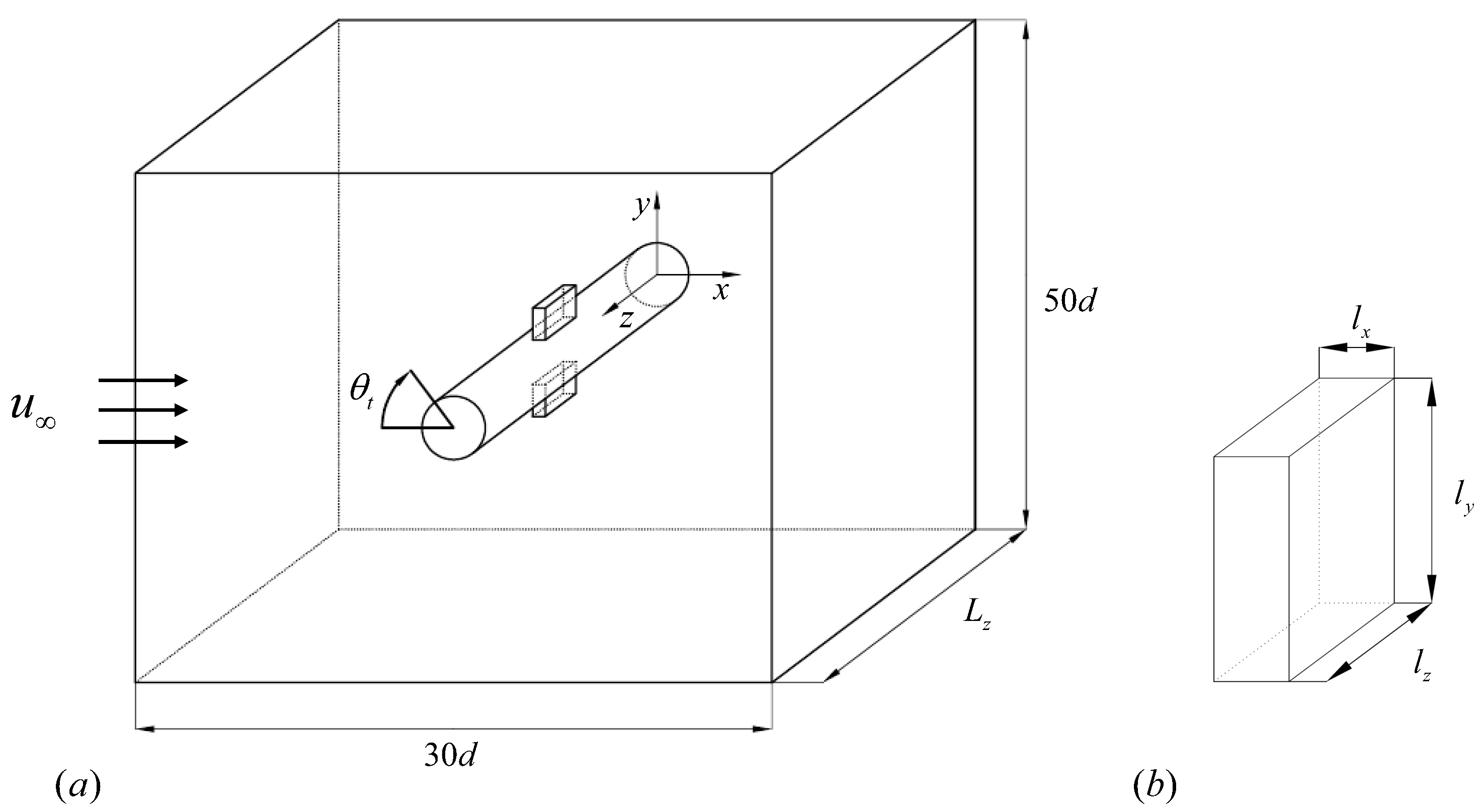

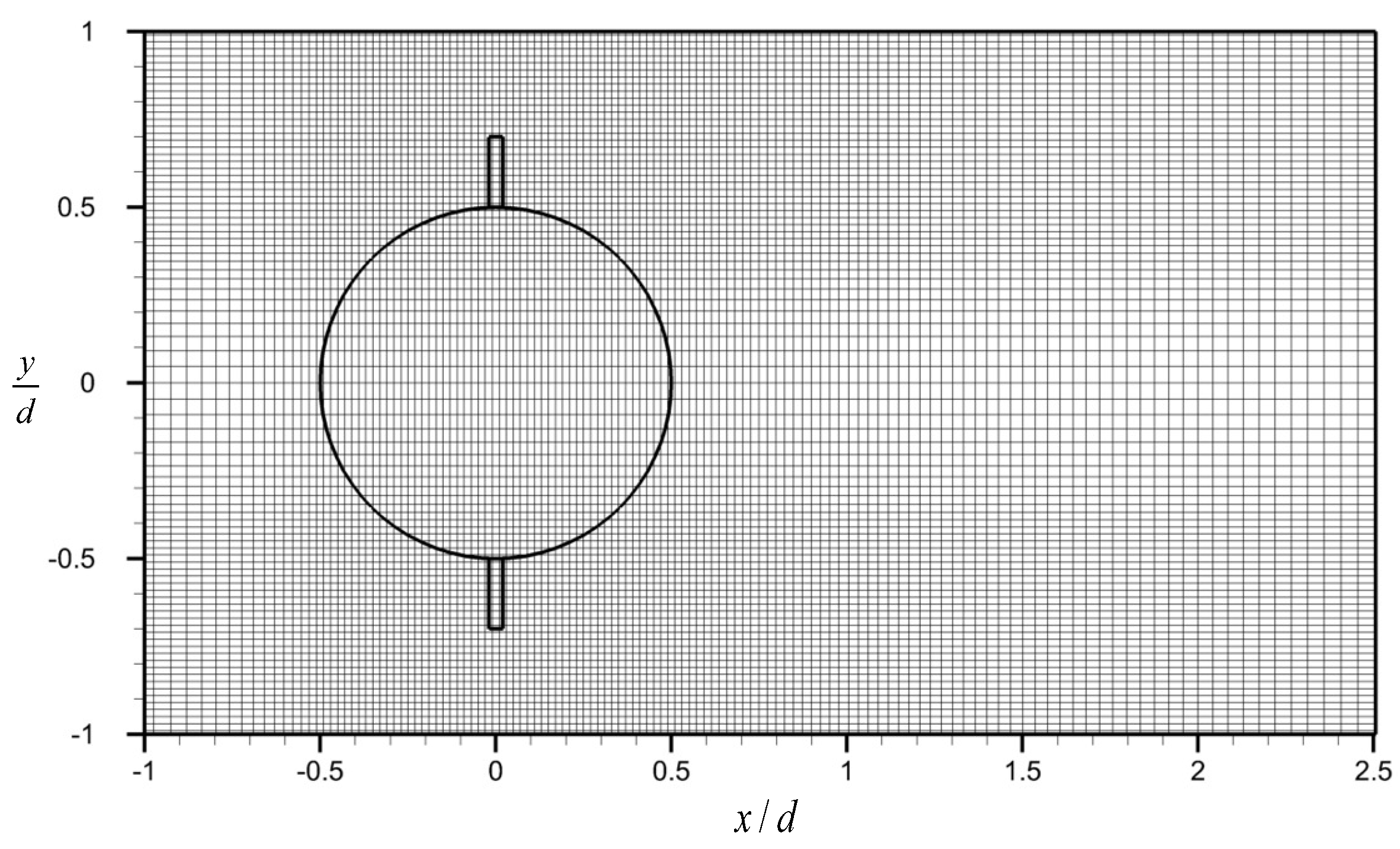
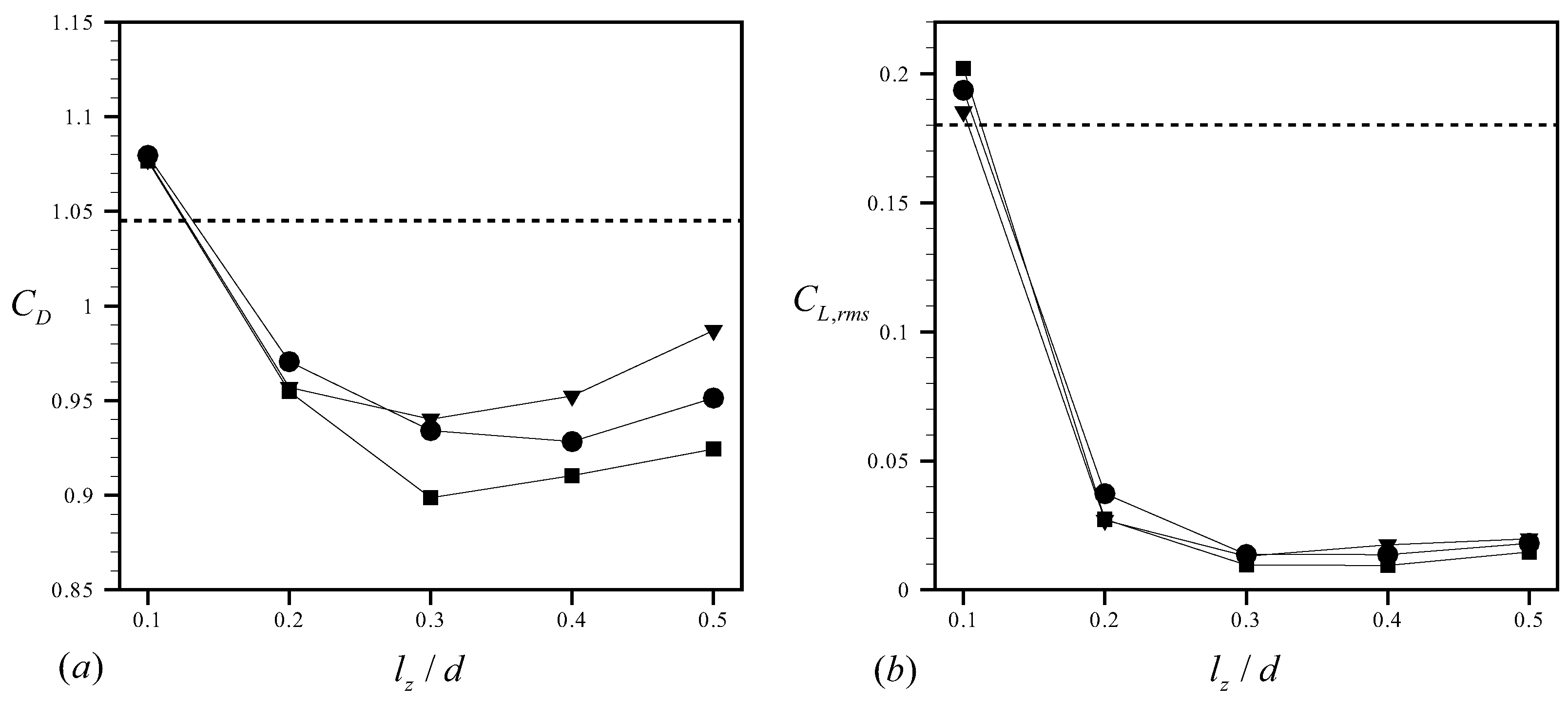
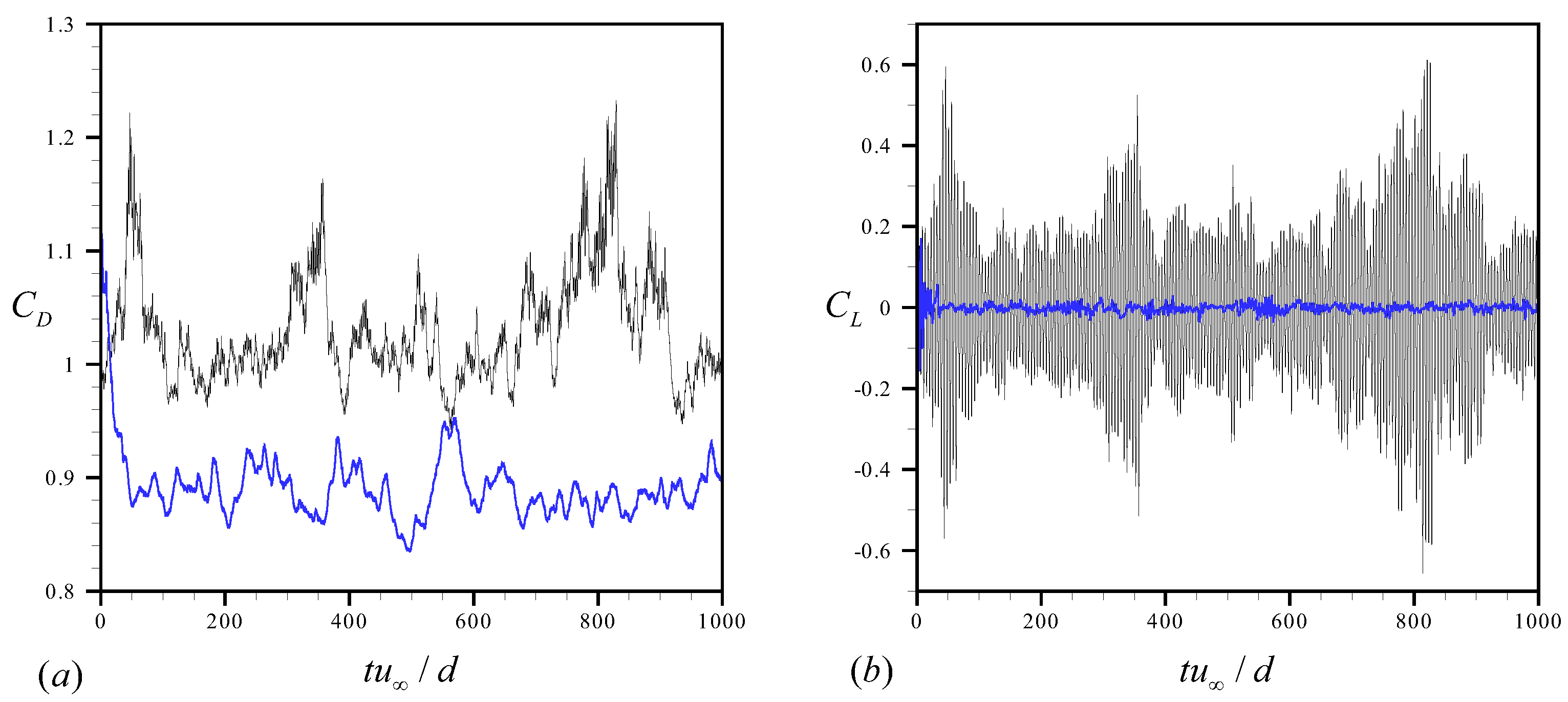

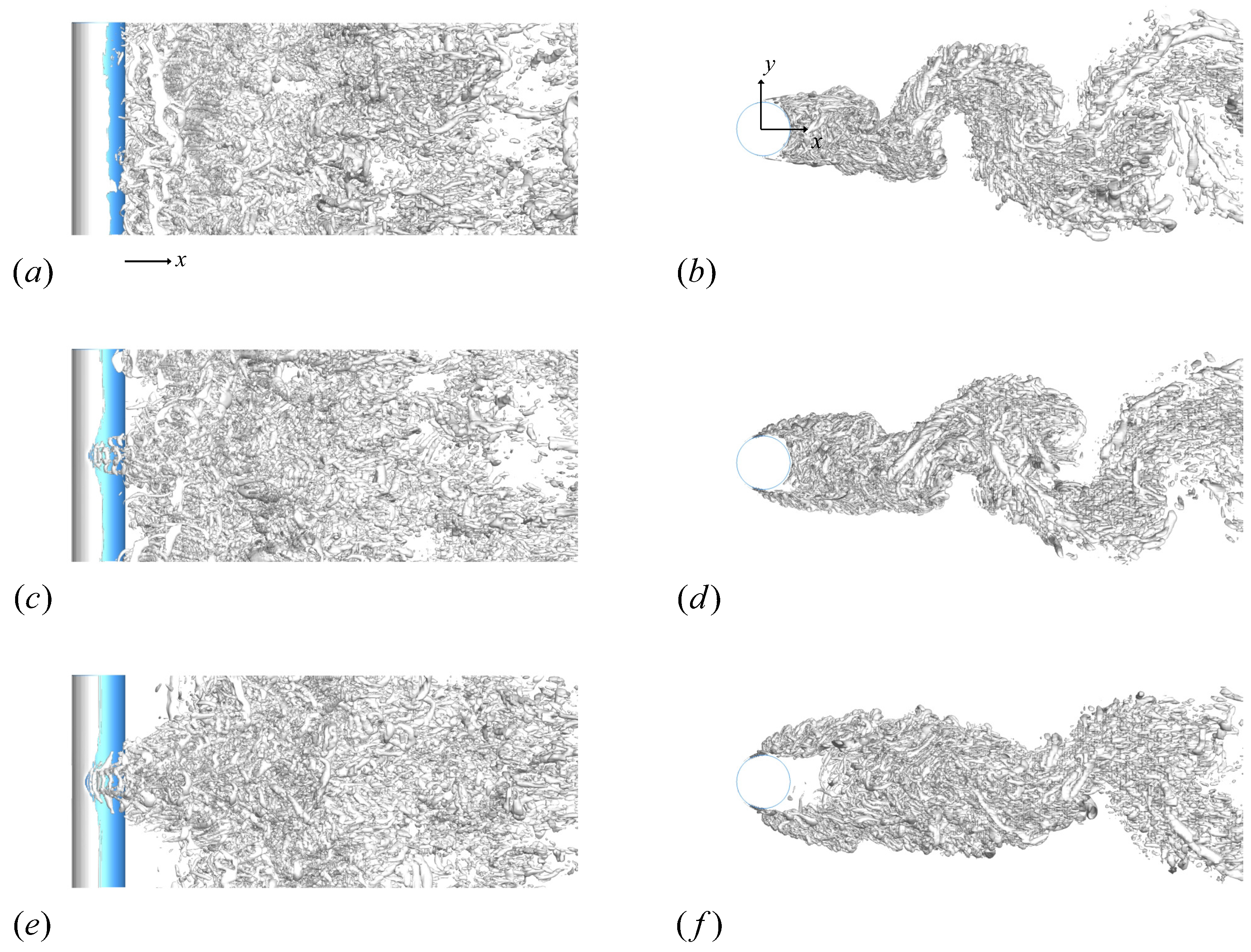

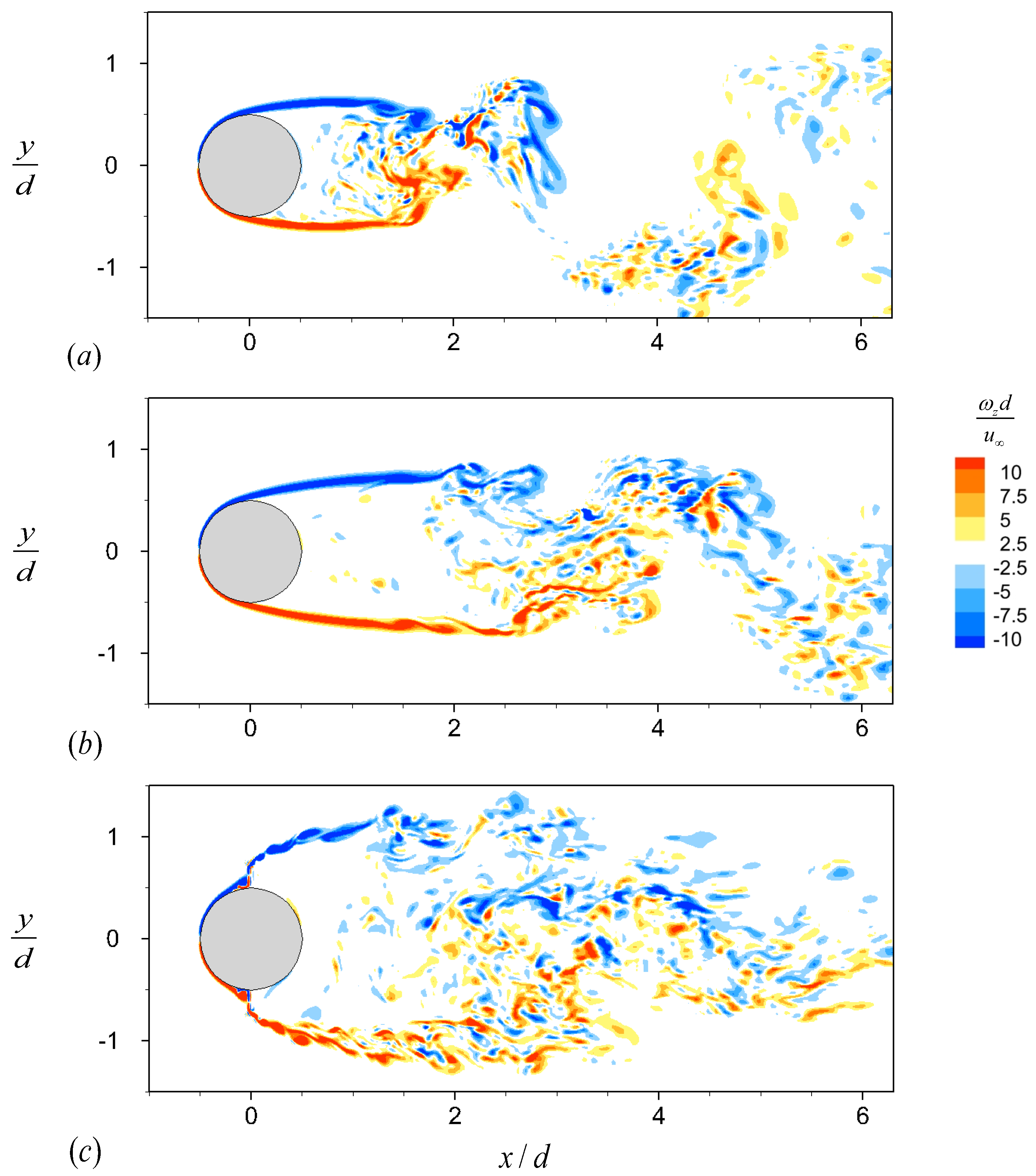
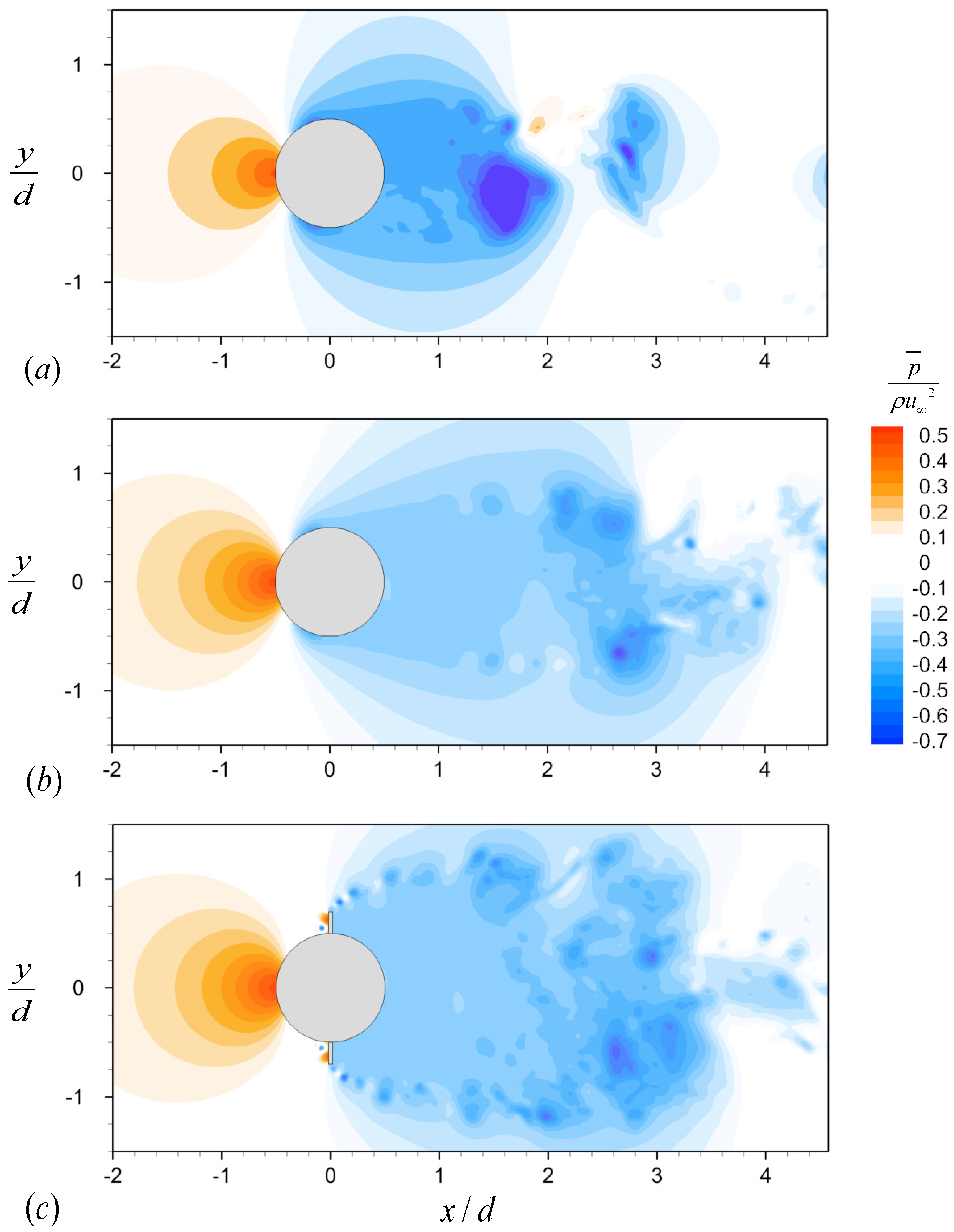
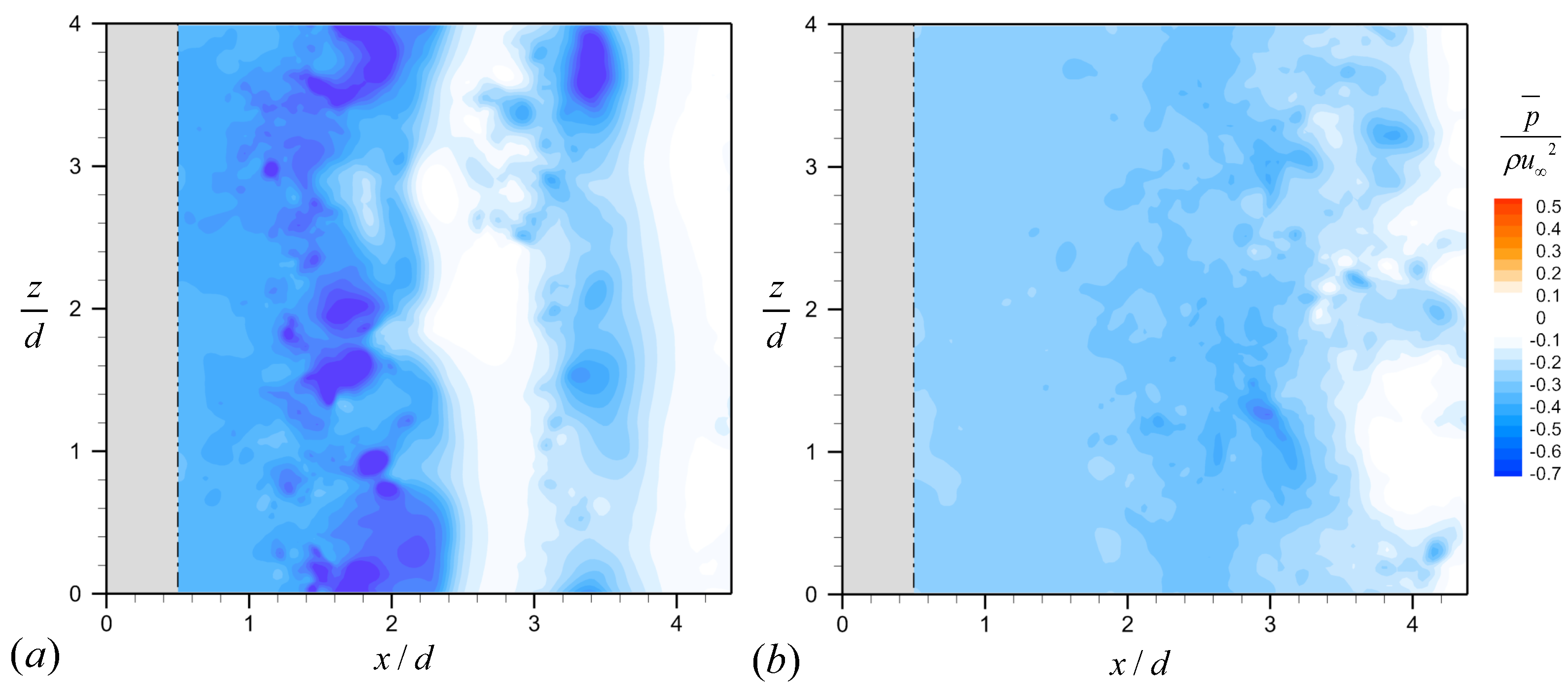
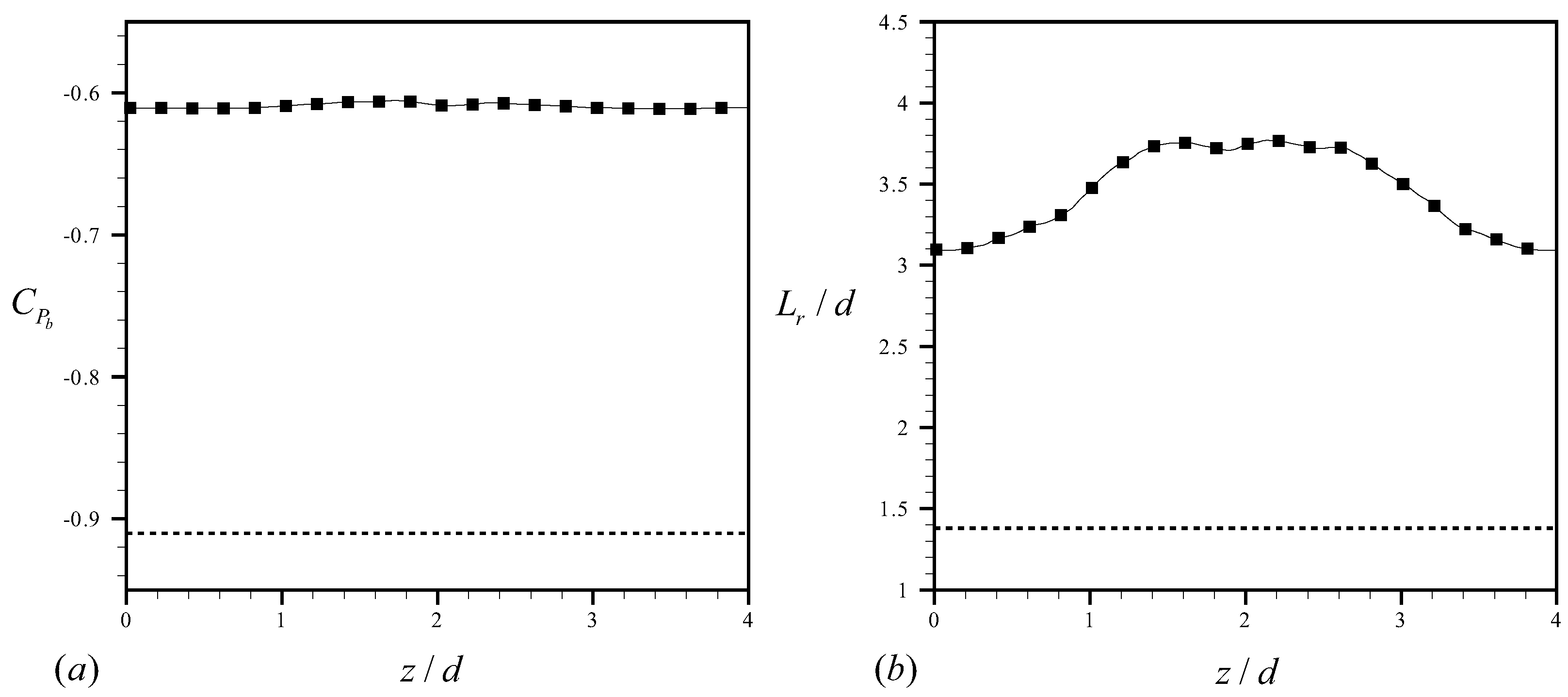
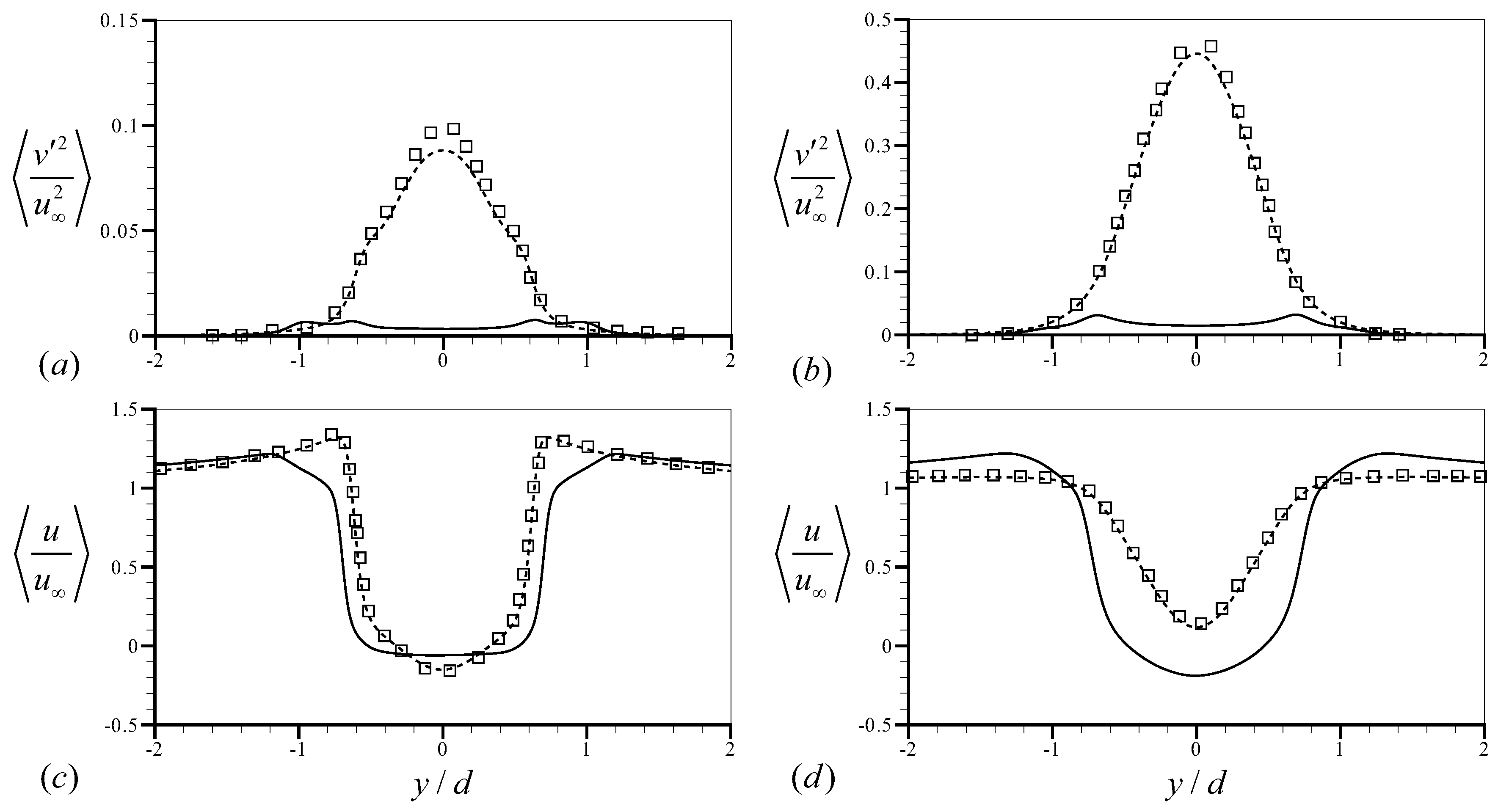
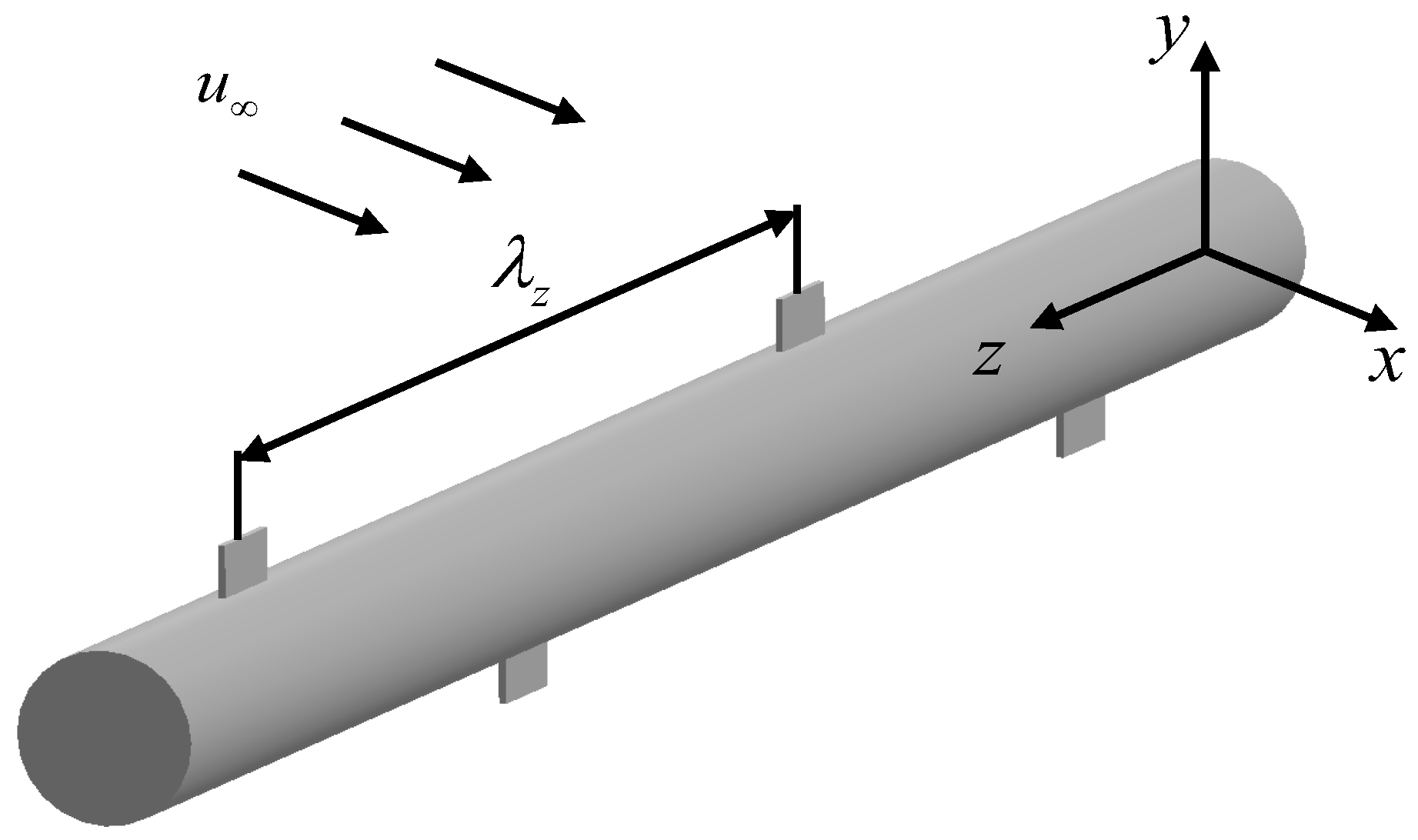
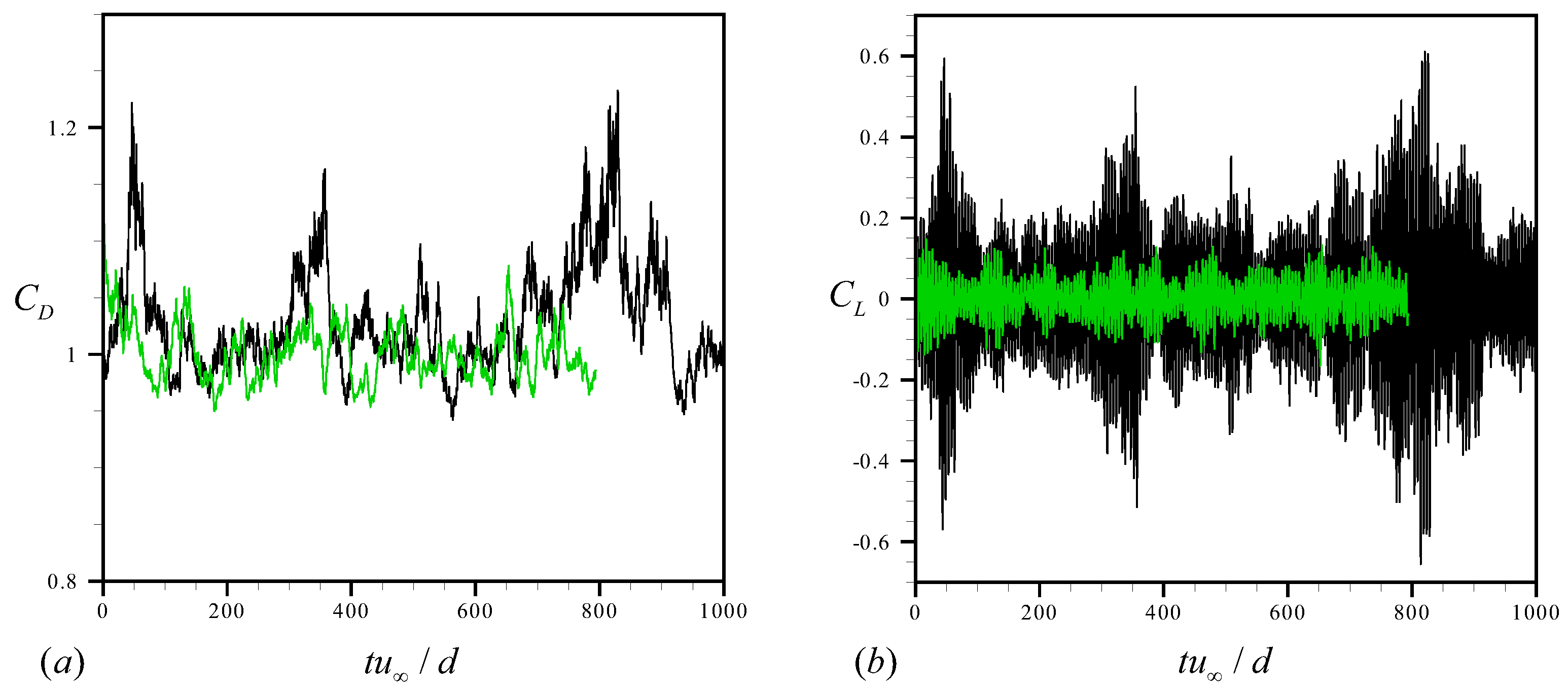
| Domain Size () | Number of Grid Points () | |||
|---|---|---|---|---|
| 0.2 | 0.1 | 4 | 513 × 331 × 160 | |
| 0.2 | ||||
| 0.3 | ||||
| 0.4 | ||||
| 0.5 | ||||
| 0.3 | 0.1 | |||
| 0.2 | ||||
| 0.3 | ||||
| 0.4 | ||||
| 0.5 | ||||
| 0.4 | 0.1 | |||
| 0.2 | ||||
| 0.3 | ||||
| 0.4 | ||||
| 0.5 | ||||
| 0.2 | 0.3 | 2 | 513 × 331 × 80 | |
| 3 | 513 × 331 × 120 | |||
| 5 | 513 × 331 × 200 | |||
| 6 | 513 × 331 × 240 |
| Case | ||||||
|---|---|---|---|---|---|---|
| Lehmkuhl et al. [44] (DNS) | 3900 | 1.015 | - | 0.215 | 1.36 | 0.935 |
| Kravchenko and Moin [43] (LES) | 3900 | 1.04 | - | 0.21 | 1.35 | 0.94 |
| Kim et al. [26] (LES) | 3900 | 1.05 | 0.25 | - | - | 0.98 |
| Lam et al. [48] (experiment) | 4000 | 1.03 | 0.16 | - | - | - |
| Lam et al. [48] (LES) | 3900 | 1.03 | 0.12 | 0.211 | - | - |
| Franke and Frank [49] (LES) | 3900 | 0.978 | - | 0.209 | 1.64 | 0.85 |
| Present study (LES) | 3900 | 1.045 | 0.18 | 0.208 | 1.38 | 0.91 |
Disclaimer/Publisher’s Note: The statements, opinions and data contained in all publications are solely those of the individual author(s) and contributor(s) and not of MDPI and/or the editor(s). MDPI and/or the editor(s) disclaim responsibility for any injury to people or property resulting from any ideas, methods, instructions or products referred to in the content. |
© 2023 by the authors. Licensee MDPI, Basel, Switzerland. This article is an open access article distributed under the terms and conditions of the Creative Commons Attribution (CC BY) license (https://creativecommons.org/licenses/by/4.0/).
Share and Cite
Seo, J.; Yun, J.; Lee, J. Control of Turbulent Flow over a Circular Cylinder Using Tabs. Mathematics 2023, 11, 968. https://doi.org/10.3390/math11040968
Seo J, Yun J, Lee J. Control of Turbulent Flow over a Circular Cylinder Using Tabs. Mathematics. 2023; 11(4):968. https://doi.org/10.3390/math11040968
Chicago/Turabian StyleSeo, Junyoung, Jinhyeok Yun, and Jungil Lee. 2023. "Control of Turbulent Flow over a Circular Cylinder Using Tabs" Mathematics 11, no. 4: 968. https://doi.org/10.3390/math11040968
APA StyleSeo, J., Yun, J., & Lee, J. (2023). Control of Turbulent Flow over a Circular Cylinder Using Tabs. Mathematics, 11(4), 968. https://doi.org/10.3390/math11040968






